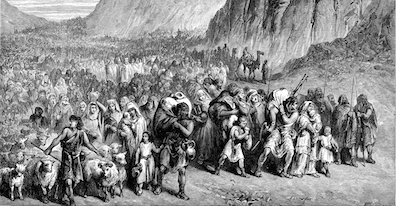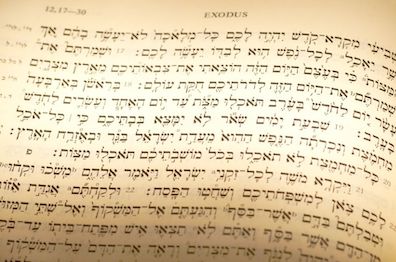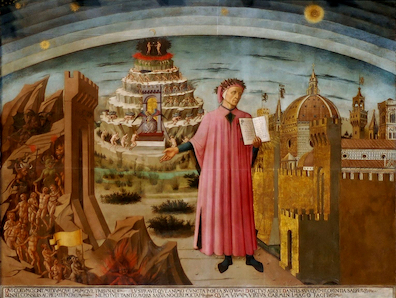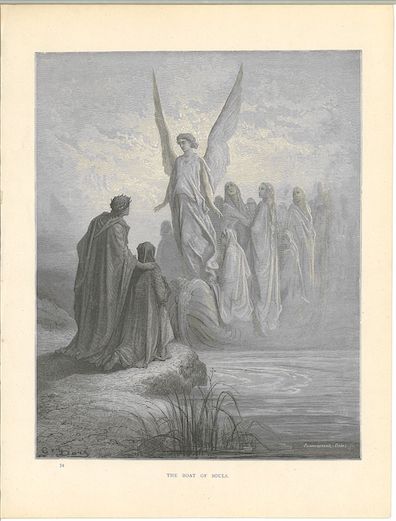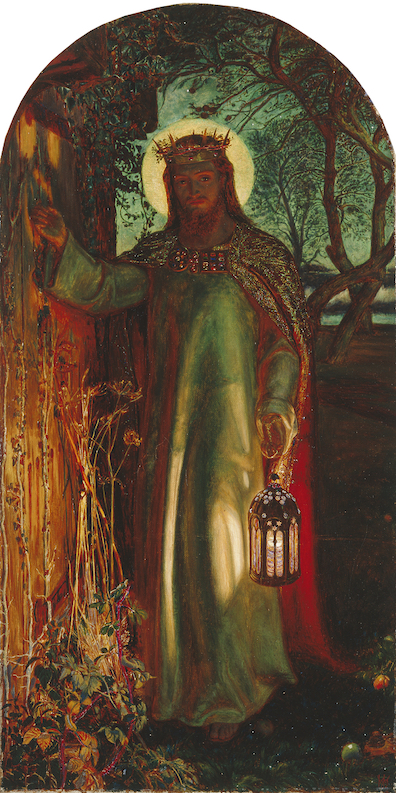Two questions and
answers introduce densely layered allusions:
In what order of
precedence, with what attendant ceremony was the exodus from
the house of bondage to the wilderness of inhabitation
effected?
Lighted Candle in Stick borne by
BLOOM
Diaconal Hat on Ashplant borne by
STEPHEN
With what intonation secreto
of what commemorative psalm?
The 113th, modus
peregrinus: In exitu Israël de Egypto: domus Jacob de populo
barbaro.
At the Seder meal of
Passover,
when Jews celebrate their liberation from Egyptian captivity,
the head of each household, assisted by his grown sons, intones
sentences from the Haggadah telling the Exodus story of the
night when an angel of God killed the firstborn sons of Egypt,
convincing the pharaoh to let his Hebrew slaves depart into the
wilderness of the Sinai peninsula. In
Aeolus Bloom
slightly misremembers the language he learned from his father:
"All that long business about that brought us out of the land of
Egypt and into the house of bondage."
Ithaca corrects
the preposition ("
the exodus from the house of
bondage to the wilderness of inhabitation"), and now Bloom
plays the patriarch, taking the "
order of precedence"
while Stephen follows behind him. Are they actually conducting a
mock ceremony? The "
intonation" of a sacred text suggests
that in fact they are.
The biblical verse chanted, "
In exitu Israël de Egypto:
domus Jacob de populo barbaro" is rendered in the
King James Bible as "When Israel went out of Egypt, the house of
Jacob from a people of strange language" (Psalms 114:1). This
verse is indeed featured in the Hebrew Haggadah and the Tanakh
on which it draws, but
Ithaca quotes it in the Latin of
the Vulgate Bible with which Stephen is familiar, where the
psalm is numbered 113. "
The 113th" psalm makes up part of
the Vespers service, a set of evening prayers usually performed
around sunset. Here it is not only chanted in Latin but
introduced by two Latin terms, suggesting that Stephen rather
than Bloom is doing the intoning. Gifford notes that "
secreto"
(secret, separated, set apart) is a direction in the
Layman's
Missal that is a possible source for Stephen's
Liliata rutilantium
prayer, indicating that a priest speaks the words "in a low
voice."
Joyce criticism has never satisfactorily explained the second
term, "
modus peregrinus." Gifford offers the gloss
"mode of going abroad," while Slote says "foreign manner." Both
translations of
peregrinus are possible: in ancient Rome
the word denoted a subject of the empire who was not a Roman
citizen (a foreigner), and by medieval times it had come to mean
something more like "traveler" (one going abroad). Gifford's
reading in particular seems well suited to the fact that Stephen
and Bloom, like the ancient Hebrews, are exiting the house and
venturing into the "
wilderness." But "mode" and "manner"
are not among the primary meanings of
modus, and neither
translation suggests why the narrative should offer this phrase
in Latin.
The religious context of Stephen's chant does. Gregorian chant
is performed in various "modes" (scales of note intervals) that
originated in antiquity. There are eight standard modes (Dorian,
Phrygian, Lydian, etc.), but Psalm 113 has traditionally been
sung in an alternate mode called
tonus peregrinus
or "wandering tone," so called because its "tenor" or "reciting
tone," the note on which most of a psalm verse is sung, varies
from the first half of the verse to the second––it wanders. In
Catholic church music the
peregrinus mode is associated
with Psalm 113 more than any other biblical text. (Whether this
pairing came about because the text itself is about wandering,
or by coincidence, I cannot say.) Perhaps Joyce misremembered
the phrase "wandering note" as "wandering mode" (it does name a
mode, after all), or perhaps by substituting
modus for
tonus he intended to evoke a second meaning, "mode of
going abroad."
It appears, then, that as Bloom leads the way to the back door
of his house he is also leading Stephen in a fanciful religious
rite, having somehow proposed that they conduct a Passover
exodus from Egypt, while Stephen plays along by chanting some
language appropriate to this theme from the Latin rituals of his
church. Like the Seder's patriarchal setting of a father leading
his sons, Catholic rites involve a fatherly "celebrant" (priest)
and his son-like assistants (deacons and altar boys). Stephen's
"
Diaconal" hat indicates that he is playing a deacon to
Bloom's celebrant, servant to his server, son to his father––an
accustomed role for him. His
choice of a Latin psalm text to complement a Jewish service
continues the sharing of ethnic, religious, and linguistic lore
that the two men engaged in earlier in
Ithaca. Indeed,
in that section of the chapter Bloom chanted the first two lines
of a Hebrew anthem: "
Kolod balejwaw pnimah / Nefesch, jehudi,
homijah." Now Stephen returns the favor.
§ Readers
who want to limit their diet of overdetermined signification to
what Joyce's words minimally require may wish to stop here, but
there is probably more to unpack from this passage. Three of its
details––the candle, the psalm, and the word
peregrinus––will
resonate for those who know Dante's
Purgatorio. The last
of these is responsible for the phrase often used to refer to
the central character of the
Divine Comedy, "Dante the
pilgrim," but Dante makes clear in an earlier work that
peregrino
does not primarily mean pilgrim. Section 40 of the
Vita
Nuova observes that it can refer to people making
devotional pilgrimages to Compostela (they are
peregrini,
while people traveling to Jerusalem are
palmieri and
those going to Rome are
romei), but this is a special
case. The general sense is simply "traveler": "
chiunque è
fuori de la sua patria," someone far away from home. There
are seven uses of the word in the
Divine Comedy, only
one of which refers to travelers on a religious mission. Five
uses come in the
Purgatorio, the poem about people
halfway between earth and heaven (dead souls) and halfway
between hell and heaven (Dante). All of them (2.63, 8.4, 9.16,
13.96, 23.16) evoke the condition of leaving home, being on the
road, venturesome, nostalgic, lost, free.
The usage relevant to
Ithaca comes in canto 2, when a
boat arrives at the base of the mountain carrying recently
deceased people who are singing Stephen's psalm: "
In exitu
Isräel de Aegypto" (46). It is clear why
Dante has them chant these words. In the letter to Cangrande
della Scala in which he explains to his patron his purposes in
writing the
Comedy, he takes the opening words of Psalm
113 as a text for illustrating the allegorical method of the
entire poem: the verse refers literally to the Hebrews' exodus
from Egypt but allegorically to the human soul's delivery from
sin. The souls in the boat are leaving their earthly lives to
enter a new realm, and they are "strangers to the place, gazing
about / as though encountering new things" (2.53-54). Not
knowing how to go up the mountain they ask Dante and Virgil for
directions, but Virgil replies, "'Perhaps you think / we are
familiar with this place, / but
we are strangers (peregrin)
like yourselves. / We came but now, a little while before
you, / by another road so rough and harsh / that now the climb
to us will seem a pastime'" (61-66). The canto, then, links the
figure of the
peregrinus to the 113th Psalm, just as
Joyce does in
Ithaca.
Virgil's words about traveling a "rough and harsh" road refer to
the trip that he and Dante took through Hell, at the end of
which they emerged to
behold the
stars––an event that Joyce will echo several sentences
later in
Ithaca. Between the end of
Inferno and
the second canto of
Purgatorio, there is another image
relevant to Joyce's exodus scene. At the base of the mountain,
its guardian Cato challenges Dante and Virgil: "What souls are
you to have fled the eternal prison...
Who was your guide or
who your lantern / to lead you forth from that deep night
/ which steeps the vale of hell in darkness?" (1.40, 43-45). In
Dante's cosmos people do not ascend to God by their own power
and understanding; everyone requires an intermediary guide.
Dante's lantern in the poem is Virgil, and he is not alone in
this respect. In
Purgatorio 22 he asks the ancient poet
Statius how he found the true faith when his works gave no
evidence of it: "what sun,
what candles dispelled your
darkness so that afterwards / you hoisted sail, following
the fisherman?" (61-63). Statius replies that it was the
writings of Virgil: "You were as
one who goes by night,
carrying / the light behind him––it is no help to him, but
instructs all those who follow" (67-69). These lines adapt St.
Augustine's description of the Jews as a people who "carried in
your hands the lamp of the law in order to show the way to
others while you remained in the darkness." Now it is a pagan
Roman poet who reveals the light of revelation to others while
not benefiting himself.
Amid all the other Dantean echoes in this part of
Ithaca,
it is hard not to hear an allusion to Virgil lighting the way
for others in Joyce's picture of a Jew leading Stephen out of
his house with a "
Lighted Candle." As an uneducated
salesman Bloom may seem an unlikely guide for Stephen, but that
is true of Virgil as well: as a poet of pre-Christian antiquity
he is an unlikely choice to show Dante the path to salvation.
Both the
Inferno and the
Purgatorio play
repeatedly on the pathos of his illuminating the way for others
while himself being condemned to Hell for not knowing God. As
Stephen follows his host to the back door of the Eccles Street
house, the allusion suggests that this Catholic apostate has
things to learn from a Jewish nonbeliever. Both Dubliners are
Dante-like exiles, lonely
peregrini
who have wandered far from the values of their native
communities. They hail from different pasts, and the parting in
Bloom's garden suggests that they are bound for different
futures as well, but their performance of a mock ritual––one
that celebrates exile––proclaims a meeting of kindred spirits
like that of the two poets Dante and Virgil.
These Dantean echoes surely represent the author's own
construction of the scene, layered on top of his characters'
fanciful enactment of a Passover ceremony. It is Joyce, not
Bloom or Stephen, who imagines the one as an important
paternal inspiration for the other and who suggests
simultaneously that they may never become friends or familial
relations. This discernment of difference in the show of
symbolic unity is also implicit in the detail "house of
bondage." For Bloom, the phrase reflects a miserable
private preoccupation. Given the meek subservience he displays
toward Molly, and her adultery on June 16, his mistake in Aeolus
may have been a Freudian slip suggesting that he sees his
house as a locus of entrapment. For Stephen, who has been
offered a place to sleep and chooses instead to wander off
into the night, the phrase may suggest entrapment of a
different kind. He has, after all, recited for Bloom the story
of the boy who went into a Jew's house to retrieve a ball and
had his head cut off with a penknife by the Jew's daughter.
Despite all they have shared in Ithaca the two men are
running along separate tracks.
